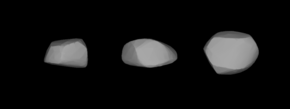 A three-dimensional model of 264 Libussa based on its light curve A three-dimensional model of 264 Libussa based on its light curve | |
| Discovery | |
|---|---|
| Discovered by | C. H. F. Peters |
| Discovery date | 22 December 1886 |
| Designations | |
| MPC designation | (264) Libussa |
| Pronunciation | German: [ˈliːbʊsaː] |
| Named after | Libuše |
| Alternative designations | A886 YA |
| Minor planet category | Main belt |
| Orbital characteristics | |
| Epoch 31 July 2016 (JD 2457600.5) | |
| Uncertainty parameter 0 | |
| Observation arc | 123.02 yr (44934 d) |
| Aphelion | 3.1799 AU (475.71 Gm) |
| Perihelion | 2.41375 AU (361.092 Gm) |
| Semi-major axis | 2.79681 AU (418.397 Gm) |
| Eccentricity | 0.13696 |
| Orbital period (sidereal) | 4.68 yr (1708.4 d) |
| Average orbital speed | 17.81 km/s |
| Mean anomaly | 254.88° |
| Mean motion | 0° 12 38.592 / day |
| Inclination | 10.426° |
| Longitude of ascending node | 49.608° |
| Argument of perihelion | 340.891° |
| Physical characteristics | |
| Dimensions | 50.48±2.7 km |
| Synodic rotation period | 9.2276 h (0.38448 d) |
| Geometric albedo | 0.2971±0.034 |
| Spectral type | S |
| Absolute magnitude (H) | 8.42 |
264 Libussa is a Main belt asteroid that was discovered by C. H. F. Peters on December 22, 1886, in Clinton, New York and was named after Libussa, the legendary founder of Prague. It is classified as an S-type asteroid.
Photometric observations of this asteroid at the Organ Mesa Observatory in Las Cruces, New Mexico, in 2008 gave an asymmetrical, bimodal light curve with a period of 9.2276 ± 0.0002 hours and a brightness variation of 0.33 ± 0.03 in magnitude. Observation from the W. M. Keck Observatory show an angular size of 57 mas, which is close to the resolution limit of the instrument. The estimated maximum size of the asteroid is about 66 ± 7 km. It has an asymmetrical shape with a size ratio of more than 1.22 between the major and minor axes.
Between 2005 and 2021, 264 Libussa has been observed to occult five stars.
References
- ^ Yeomans, Donald K., "264 Libussa", JPL Small-Body Database Browser, NASA Jet Propulsion Laboratory, retrieved 11 May 2016.
- ^ Pilcher, Frederick; Jardine, Don (April 2009), "Period Determinations for 31 Euphrosyne, 35 Leukothea 56 Melete, 137 Meliboea, 155 Scylla, and 264 Libussa", The Minor Planet Bulletin, 36 (2): 52–54, Bibcode:2009MPBu...36...52P
- Schmadel, Lutz D. (2007). "(264) Libussa". Dictionary of Minor Planet Names – (264) Libussa. Springer Berlin Heidelberg. p. 38. doi:10.1007/978-3-540-29925-7_265. ISBN 978-3-540-00238-3.
- Marchis, F.; et al. (November 2006), "Shape, size and multiplicity of main-belt asteroids. I. Keck Adaptive Optics survey", Icarus, 185 (1): 39–63, Bibcode:2006Icar..185...39M, doi:10.1016/j.icarus.2006.06.001, PMC 2600456, PMID 19081813, retrieved 27 March 2013.
External links
- The Asteroid Orbital Elements Database
- Minor Planet Discovery Circumstances
- Asteroid Lightcurve Data File
- 264 Libussa at AstDyS-2, Asteroids—Dynamic Site
- 264 Libussa at the JPL Small-Body Database

| Minor planets navigator | |
|---|---|
| Small Solar System bodies | |||||||
|---|---|---|---|---|---|---|---|
| Minor planets |
| ||||||
| Comets | |||||||
| Other | |||||||
This article is a stub. You can help Misplaced Pages by expanding it. |